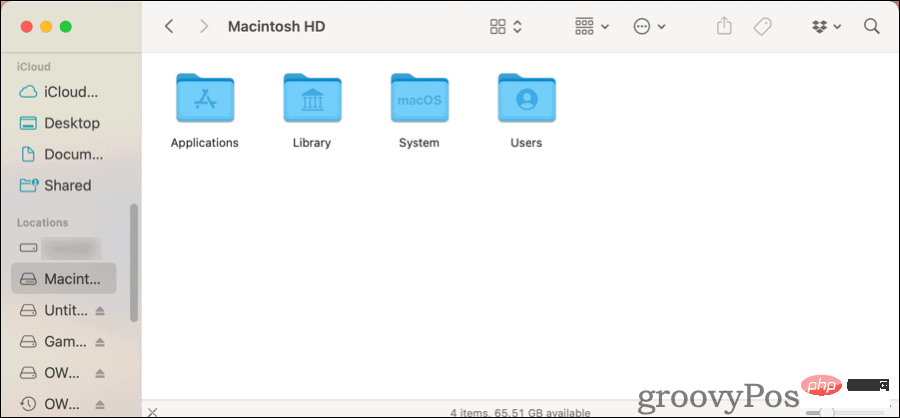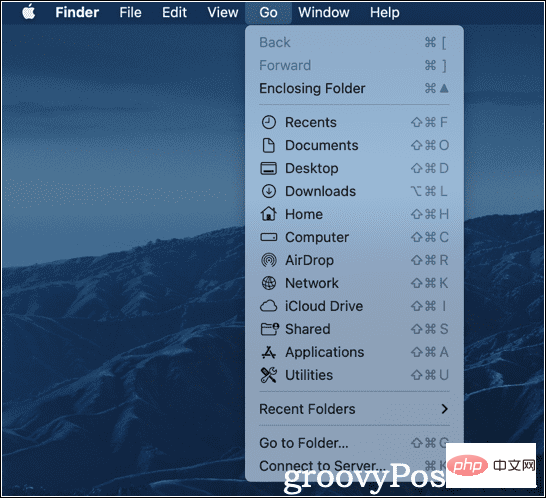How to show hidden files on Mac
How to View Hidden Files on Mac
If you prefer to work by clicking, you can use the Finder app to show hidden files on macOS. Here's how it's done.
- Under Locations, click on your hard drive folder, probably named Macintosh HD.

- When you first open it you won't see much, so press Command Shift Period. You'll see a number of other files and folders that are slightly grayed out to mark them as hidden.

- Press the same key combination and these files and folders will disappear again.
This same key combination will work no matter which folder you have open in Finder.
How to Access the macOS Library Folder
Now, let’s say you just need to access your Mac’s Libraryfolder~/Library. You don't need to browse through all of your computer's folders to get there.
- In the top menu of Finder, click Go.

- Initially, you won't see the libraries listed at all. Hold down the Option key and a new Library option will appear. Click it and your Mac's ~/Library folder will open in a new Finder window.

How to Show Hidden Files on Mac Using Terminal
If you prefer working in Terminal, you can enable Show hidden files here. Just type the following commands:
defaults write com.apple.finder AppleShowAllFiles truekillall Finder
Once these commands run, a few things will happen. The Finder application will exit and restart on its own. You may see your desktop icons disappear and then reappear. Afterwards, you will be able to view all hidden files in Finder, as well as any temporary files saved on your desktop.
When you want to hide them again, you repeat these commands, replacing the value true with false.
defaults write com.apple.finder AppleShowAllFiles falsekillall Finder
Again, Finder will exit and restart. Those hidden files will be hidden from view again.
How to Hide Files on Mac Using Terminal
You might think this is more useful than doing everything in the Finder. However, Terminal can be great if you have files and folders on your Mac that aren't hidden but you want them to be.
To do this, here's what you need to do.
- OpenFinder to the directory containing the file you want to hide.
- In Terminal, type
chflags hidden, followed by a space, but do not press Enter. - Drag the file or folder you want to hide from Finder to TerminalWindow.
- The file or folder name will appear at the end of the
chflagscommand. - Now press Enter.
This will hide your file or folder from view. You can show it again using the terminal command above to make sure.
Quickly and temporarily display hidden files in Terminal
If you don't need or want to change how the Finder displays hidden files, you can list them in Terminal. You can do this using the command ls, list as appropriate.
- From Terminal, type
ls -a - You will see all the files in the current directory, including hidden files and folders .
This is the -a flag that makes a difference here. It tells the list command to display all files. If you want to do this on a different folder, that's easy.
- From the terminal, type
ls -a ~/.config - Just replace
~/.configis the folder you want to view.
If you need to open this file or folder in the GUI, you can do so using the open command. Here is an example:
-
open .not_visiblewill launch a file named .not_visible, assuming there is an application associated with it.
The same method also works for opening hidden folders in Finder.
-
open ~/.configwill open the hidden folder .config in a Finder window.
Be careful with hidden files
Remember, these files and folders are hidden for a good reason. If you accidentally delete or move folders or files that macOS depends on, it can cause some major problems. You may find yourself having to restore the operating system and then the remaining files and applications in Time Machine.
Please note that this does not mean don't try to use hidden files and folders. Just use your best judgment, err on the side of caution, and double-check what you're doing before you commit.
The above is the detailed content of How to show hidden files on Mac. For more information, please follow other related articles on the PHP Chinese website!

Hot AI Tools

Undresser.AI Undress
AI-powered app for creating realistic nude photos

AI Clothes Remover
Online AI tool for removing clothes from photos.

Undress AI Tool
Undress images for free

Clothoff.io
AI clothes remover

AI Hentai Generator
Generate AI Hentai for free.

Hot Article

Hot Tools

Notepad++7.3.1
Easy-to-use and free code editor

SublimeText3 Chinese version
Chinese version, very easy to use

Zend Studio 13.0.1
Powerful PHP integrated development environment

Dreamweaver CS6
Visual web development tools

SublimeText3 Mac version
God-level code editing software (SublimeText3)

Hot Topics
 1381
1381
 52
52
 3 tips to easily customize your Mac computer name, host name and Bonjour name
Mar 06, 2024 pm 12:20 PM
3 tips to easily customize your Mac computer name, host name and Bonjour name
Mar 06, 2024 pm 12:20 PM
Many Mac users tend to keep the default name of their device and may never consider changing it. Many people choose to stick with the name from the initial setup, such as "Johnny's MacBook Air" or simply "iMac." Learning how to change the name of your Mac is a very useful skill, especially when you have multiple devices, as it can help you quickly distinguish and manage them. Next, we will teach you step by step how to change the computer name, host name and Bonjour name (local host name) in macOS system. Why should you change your Mac name? Changing the name of your Mac can not only show your personality, but also help improve the user experience: Personalize your Mac: The default name may not be to your taste, change it to a name you like.
 What software is crystaldiskmark? -How to use crystaldiskmark?
Mar 18, 2024 pm 02:58 PM
What software is crystaldiskmark? -How to use crystaldiskmark?
Mar 18, 2024 pm 02:58 PM
CrystalDiskMark is a small HDD benchmark tool for hard drives that quickly measures sequential and random read/write speeds. Next, let the editor introduce CrystalDiskMark to you and how to use crystaldiskmark~ 1. Introduction to CrystalDiskMark CrystalDiskMark is a widely used disk performance testing tool used to evaluate the read and write speed and performance of mechanical hard drives and solid-state drives (SSD). Random I/O performance. It is a free Windows application and provides a user-friendly interface and various test modes to evaluate different aspects of hard drive performance and is widely used in hardware reviews
 CrystalDiskinfo usage tutorial-What software is CrystalDiskinfo?
Mar 18, 2024 pm 04:50 PM
CrystalDiskinfo usage tutorial-What software is CrystalDiskinfo?
Mar 18, 2024 pm 04:50 PM
CrystalDiskInfo is a software used to check computer hardware devices. In this software, we can check our own computer hardware, such as reading speed, transmission mode, interface, etc.! So in addition to these functions, how to use CrystalDiskInfo and what exactly is CrystalDiskInfo? Let me sort it out for you! 1. The Origin of CrystalDiskInfo As one of the three major components of a computer host, a solid-state drive is the storage medium of a computer and is responsible for computer data storage. A good solid-state drive can speed up file reading and affect consumer experience. When consumers receive new devices, they can use third-party software or other SSDs to
 How to set the keyboard increment in Adobe Illustrator CS6 - How to set the keyboard increment in Adobe Illustrator CS6
Mar 04, 2024 pm 06:04 PM
How to set the keyboard increment in Adobe Illustrator CS6 - How to set the keyboard increment in Adobe Illustrator CS6
Mar 04, 2024 pm 06:04 PM
Many users are using the Adobe Illustrator CS6 software in their offices, so do you know how to set the keyboard increment in Adobe Illustrator CS6? Then, the editor will bring you the method of setting the keyboard increment in Adobe Illustrator CS6. Interested users can take a look below. Step 1: Start Adobe Illustrator CS6 software, as shown in the figure below. Step 2: In the menu bar, click the [Edit] → [Preferences] → [General] command in sequence. Step 3: The [Keyboard Increment] dialog box pops up, enter the required number in the [Keyboard Increment] text box, and finally click the [OK] button. Step 4: Use the shortcut key [Ctrl]
 How to set up WeChat Mac to automatically convert voice messages into text - How to set up voice to text conversion
Mar 19, 2024 am 08:28 AM
How to set up WeChat Mac to automatically convert voice messages into text - How to set up voice to text conversion
Mar 19, 2024 am 08:28 AM
Recently, some friends have consulted the editor about how to set up WeChat Mac to automatically convert voice messages into text. The following is a method for setting up WeChat Mac to automatically convert voice messages into text. Friends in need can come and learn more. Step 1: First, open the Mac version of WeChat. As shown in the picture: Step 2: Next, click "Settings". As shown in the picture: Step 3: Then, click "General". As shown in the picture: Step 4: Then check the option "Automatically convert voice messages in chat to text". As shown in the picture: Step 5: Finally, close the window. As shown in the picture:
 How to resolve an incompatible software attempt to load with Edge?
Mar 15, 2024 pm 01:34 PM
How to resolve an incompatible software attempt to load with Edge?
Mar 15, 2024 pm 01:34 PM
When we use the Edge browser, sometimes incompatible software attempts to be loaded together, so what is going on? Let this site carefully introduce to users how to solve the problem of trying to load incompatible software with Edge. How to solve an incompatible software trying to load with Edge Solution 1: Search IE in the start menu and access it directly with IE. Solution 2: Note: Modifying the registry may cause system failure, so operate with caution. Modify registry parameters. 1. Enter regedit during operation. 2. Find the path\HKEY_LOCAL_MACHINE\SOFTWARE\Policies\Micros
 3 Ways to Convert HEIC Photos to JPG on Mac
Mar 15, 2024 pm 08:43 PM
3 Ways to Convert HEIC Photos to JPG on Mac
Mar 15, 2024 pm 08:43 PM
By default, iPhone takes photos from the camera in HEIC format. HEIC stands for High Efficiency Image Container and can hold more pixel data than PNG or JPG files, taking up significantly less space on iPhone storage compared to other formats. These files work best on iPhones but are not widely accepted on the internet because they often result in blurry/grainy pictures when you share them with non-Apple devices. To ensure that HEIC images are compatible on other devices, you may need to convert them to JPG format. This article will introduce how to convert HEIC images to JPG on Mac. How to Convert HEIC Photos to JPG on Mac [3 Methods] Method
 What software is photoshopcs5? -photoshopcs5 usage tutorial
Mar 19, 2024 am 09:04 AM
What software is photoshopcs5? -photoshopcs5 usage tutorial
Mar 19, 2024 am 09:04 AM
PhotoshopCS is the abbreviation of Photoshop Creative Suite. It is a software produced by Adobe and is widely used in graphic design and image processing. As a novice learning PS, let me explain to you today what software photoshopcs5 is and how to use photoshopcs5. 1. What software is photoshop cs5? Adobe Photoshop CS5 Extended is ideal for professionals in film, video and multimedia fields, graphic and web designers who use 3D and animation, and professionals in engineering and scientific fields. Render a 3D image and merge it into a 2D composite image. Edit videos easily







